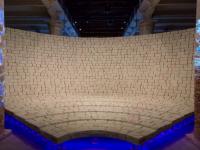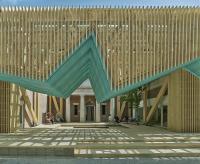McDonald’s Chicago Flagship
Chicago, États-Unis
The new Chicago Flagship celebrates the pure simplicity and enduring authenticity of McDonald’s, welcoming both residents and visitors to a playful and informal gathering place in the heart of the city.
The site is a full city block, just steps off Michigan Avenue, occupied since 1983 by the iconic “Rock ‘n Roll” McDonald’s that emphasized drive through services. The new design re-balances car-pedestrian traffic creating a city oasis where people can eat, drink and meet. Landscape area increase 72% with 43% of the site being open and pedestrian focused, producing a new park-like amenity for a dense area of the city.
The dining room features a garden planted with ferns and white birch trees floating above a digital ordering “street”. From this vantage point guests can experience the landscape beyond and above. Over shared tables with wireless charging and outlets, “tapestries” of living plants improve indoor air quality and provide a backdrop of green gradients. What might surprise many can be found on the adjacent kitchen roof: a row of harvestable apple trees can be seen through a clerestory window, telling a story about the future of urban farming and the utilization of often underused space.
McDonald’s corporate commitment to “make sustainability the new normal” is at the core of the new restaurant design. The structural system, Cross Laminated Timber (CLT), is the first commercial use in Chicago and has a lighter environmental footprint than concrete and steel. The solar pergola captures the sun’s energy, supplying part of the buildings consumption needs. Throughout the site, permeable paving is used to reduce storm water runoff and the heat island effect. The building is designed to achieve LEED certification.
- Architectes
- Ross Barney Architects
- Lieu
- 600 North Clark Street, 60654 Chicago, États-Unis
- Année
- 2018
- Client
- McDonald’s Corporation
- Interior Design
- Landini Associates
- Structural Engineer
- Goodfriend Magruder Structures
- Green Wall and Green Roof Design
- Omni Ecosystems
- Mechanical and Plumbing Engineer
- WCW Engineers
- Electrical Engineering
- Dickerson Electrical Engineers
- Lighting Design
- Schuler Shook
- PV Solar Pergola Design
- Day and Night Solar
- Civil Engineering
- Watermark Engineering
- Surveyor
- Compass Surveying



















